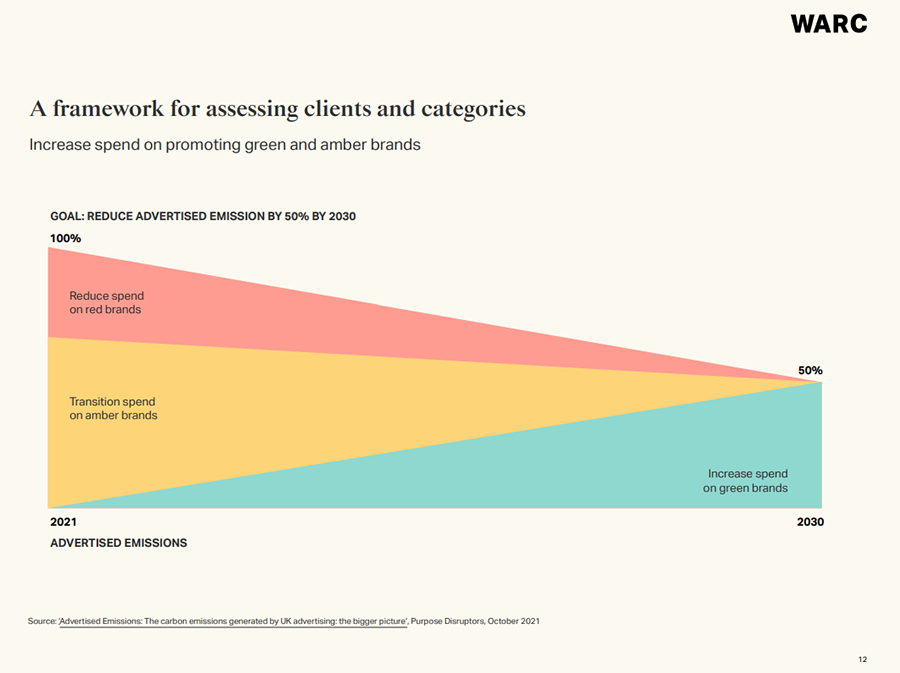As the latest IPCC report stresses the urgency of addressing climate change, WARC’s Lena Roland reviews how the industry is responding, including Ad Net Zero.
WARC will be exhibiting the sustainability hub, the WARC Guide to Net Zero Marketing, and other best practice content at this year’s Cannes Lion Festival of Creativity. Join us this Wednesday, 21st June in the ACT Responsible Hall Debussy, Palais des Festivals.
Action is needed everywhere, now
The latest climate report from the United Nations Intergovernmental Panel on Climate Change (IPCC) finds that greenhouse gas (GHG) emissions are not decreasing fast enough.
The report states that “keeping warming to 1.5°C above pre-industrial levels requires deep, rapid and sustained greenhouse gas emissions reductions in all sectors. Emissions should be decreasing by now and will need to be cut by almost half by 2030, if warming is to be limited to 1.5°C”.
UN secretary-general António Guterres described the IPCC report as “a how-to guide to defuse the climate time-bomb – it is a survival guide for humanity”. The 1.5 degree limit is achievable, he added, “but it will take a quantum leap in climate action … Our world needs climate action on all fronts: everything, everywhere, all at once.”
Ad Net Zero: what the industry can do
Sustainability is now a priority for marketers with 89% of respondents to WARC’s global Marketer’s Toolkit survey saying it is important to their 2023 marketing strategies, including 40% who said sustainability would significantly impact their marketing plans.
In late 2020 the UK advertising industry launched Ad Net Zero, a project that aims to achieve carbon net zero by 2030. Backed by the Advertising Association (AA), along with the Institute of Practitioners in Advertising (IPA), and the Incorporated Society of British advertisers (ISBA), its mission is to bring about collective, industrywide action to cut carbon emissions associated with advertising, across the whole process of development, production and media placement, in order to make the industry carbon neutral by 2030. Reflecting the global nature of this challenge, Ad Net Zero launched in the US in February this year and plans to expand into other markets.

WARC’s Sustainability hub
Closer to home, WARC has created a Sustainability hub, launched in partnership with LIONS, the home of creativity, and the UK’s Advertising Association, to showcase the latest best practice, research, expert guidance and case studies to help marketers understand and help solve the challenges of sustainability, including net zero.
The WARC Guide to Net Zero Marketing provides a roadmap to help the industry achieve net zero targets, providing frameworks and strategies that can be adopted and applied. Key actions include:
- Reduce the climate impact of advertising production. This means rethinking how adverts are made.
- Review media plans. Take a lean approach to media planning – less wastage and less retargeting means fewer carbon emissions. In this context, brands that can generate quick recall will have an advantage.
- Drive behaviour change. There are many options here: the industry can use its renowned creativity to tell stories about the benefits of sustainable behaviour and lifestyles. Brands can reframe the narrative so the focus is on opportunities, not sacrifice: research by Kantar and Affectiva shows the most effective climate/sustainability campaigns leave people feeling inspired. (Guilt tactics can be useful, but, if used wrongly, this approach can lead to apathy.)
Brands can develop a circular economy strategy, making it easy for consumers to recycle, reuse, rent and resell. Or they can incentivise and reward green behaviour. Or they could take an educational stance, providing people with clear and helpful messaging. Consider applying behavioural economics to encourage people to adopt sustainable behaviour and close consumers’ intention-action gap. As behavioural scientist Richard Thaler puts it: “If you want to get somebody to do something, make it easy.”
- Incorporate climate impact metrics. In 2021 the Purpose Disruptors and econometrics agency Magic Numbers introduced a new metric, Advertised Emissions. The goal is to help the industry measure emissions to establish a baseline, and then track their performance in reducing them.
- Avoid greenwashing. It’s dangerous. As the number of companies setting net zero targets increases, brands must beware the perils of greenwashing, which will be called out by consumers, employees and regulators. Companies that do not have an actionable and verifiable net zero target will come under increased scrutiny from investors, consumers, employees or communities in the long term.
- Invest in green growth. The Purpose Disruptors recommend the industry increase spend to grow green brands. Clean Creatives, an industry collective, pledges to decline future contracts with the fossil fuel industry.
- Collaborate and share best practice. Radical collaboration between all stakeholders – businesses, suppliers, investors, policymakers and consumers – is required.
So avoid vague, misleading and unsubstantiated claims. Be clear, honest and transparent.
Understand too that greenwashing exists on a spectrum. “We cannot let greenwashing go unchecked, but we also cannot let fear of greenwashing stop us from making progress”, says Oliver Feldwick, Head of Innovation at The&Partnership. It is important to differentiate the different degrees of greenwashing – from toxic, murky to green shoots.

Ultimately, overt or underhand greenwashing should be called out. But brands that were not ‘born’ green should be allowed to share their sustainability success stories, to expedite progress. As Voltaire said, perfection is the enemy of the good.

Not only is addressing the climate emergency the right thing to do, for brands it’s also about risk-minimisation, its about winning the talent war, reassuring investors, and ensuring the brand is future-fit.
If you would like to contribute your sustainability research, case studies or expert guidance, please get in touch.

